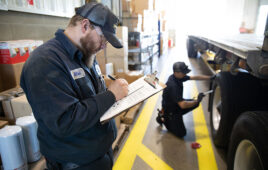With a focus on healthy food, aggressive expansion plans and a c-store model that evades the boundaries of normal classification, Green Zebra gallops ahead.
By Erin Rigik Del Conte, Senior Editor
The moment customers set foot inside a Green Zebra store, it’s clear this isn’t the type of convenience store where “Bubba” buys his smokes and lottery tickets, but Green Zebra Grocery, based in Portland, Ore., isn’t looking to be traditional.
Rather, the chain is on a mission to increase access to healthy foods. It’s also poised for an aggressive expansion, which will take its business from the two locations currently open to 20 stores by 2020. In addition, Green Zebra is growing vertically into territory not usually the domain of convenience store companies, including the launch of a new catering program.
From its employee benefits to its focus on fresh and healthy prepared foods to its community involvement, Green Zebra is a chain to watch in 2016 and beyond.
“The thing that makes us unique is we’re combining healthy and convenience. Generally speaking, people don’t think of convenience stores as being healthy and shopping at healthy stores isn’t always convenient,” said Lisa Sedlar, CEO of Green Zebra.

DEFINING GREEN ZEBRA
With its made-from-scratch foods, fresh produce and extensive beer and wine selection, Green Zebra clearly has a unique c-store model; one that has caused many to question if it can, in fact, be defined as a convenience store chain. But Sedlar isn’t worried about the way people choose to classify her chain.
“We get to redefine what it means to be a convenience store in America,” said Sedlar. “People are always trying to say, ‘Oh, this isn’t a convenience store. Oh, it’s more of a small grocery store.’ Well, it’s a Green Zebra.”
As such, Green Zebra incorporates elements of convenience and grocery.
Like most c-stores, Green Zebra has a small footprint compared to a grocery store, features a limited selection of products, offers grab-and-go food items and focuses on getting people in and out quickly—within 5-10 minutes. Grab-and-go items are available via a salad bar and hot foods bar.
Similar to a grocery store, the chain offers a range of categories and a produce department that offers organic, local and seasonal items. “Produce is 11% of our sales,” Sedlar noted. The stores also offer a full-service meat counter, featuring grass-fed beef and sustainably-raised fish, as well as kabobs and five different kinds of sausages, which are made in the store.
Unlike a traditional c-store, Green Zebra does not sell lottery tickets nor does it sell tobacco products. “We think that there’s nothing healthy about selling cigarettes,” Sedlar said.
Health is a huge focus of Green Zebra’s business model, given that its mission is to increase access to healthy foods. Often c-stores are the only choice in a neighborhood for convenient food. “We wanted to up the ante and say, ‘If this is your choice for food, we’re going to make sure that you have lots of healthy options,’” Sedlar said.
GROWING FORWARD
Green Zebra opened its first store—at 5,550 square feet—in Portland’s Kenton neighborhood in 2013. In April 2016, the chain debuted its second store—an 8,200-square-foot ground-up build—in the Lloyd District, a business-oriented neighborhood. The new location features additional market space—including a larger deli—to cater to a lunchtime crowd.
“We knew with it being in the business district there would be a huge lunchtime population,” Sedlar said.
The Lloyd District store sees 70% of its sales between 7 a.m. and 1 p.m. “We just get slammed at lunch. There are hundreds of people coming in. Our No. 1 seller for this store is our custom-made sandwiches,” Sedlar said. The No. 2 best-selling item is the hot bar, with the salad bar coming in at No. 3. “It shows that people are wanting this healthy convenience,” she added.
In October, Green Zebra is set to open its third store—at 4,200-square feet—on the Portland State University campus. The chain acquired an existing property for the new store and is expanding the location.
Green Zebra expects the coffee trip to be especially important at the university location and plans to staff baristas to serve Stumptown Coffee, a popular brand made by a local Portland roaster, and an array of lattes. The chain has already seen success using baristas at its two existing locations: coffee and pastry combined currently make up 7% of store sales.
The university site will also offer a hot dog station featuring hot dogs made with sustainably-raised beef and numerous topping options, including the cream cheese and grilled onions needed to make a “Seattle dog.” The site will also have a large emphasis on healthy snacks and, like the Kenton and Lloyd District stores, and will feature kombucha on tap.
Kombucha, a variety of fermented, carbonated, sweetened iced tea considered a functional beverage with healthy benefits, is hugely popular in the Portland area. “We look at kombucha as the next Slurpee,” Sedlar said.
At Green Zebra locations, eight self-serve taps offer an array of kombucha flavors from various vendors, and customers can choose to fill up their own container—be it a cup or a growler.
The company is planning for a fourth store, set to open in August 2017 at the corner of 50th and Division in Portland—between two popular neighborhoods that are both exploding with growth.
The store is a raze and rebuild of a location that formerly held a Safeway. A mixed-use building is being constructed in its place, and Green Zebra will occupy the ground floor and span 7,000 square feet. About 125 apartments will occupy the space above the store.
PIONEERING VALUES
Sedlar thinks Green Zebra customers are most surprised by the high level of service they receive. “We’re values based, and we live and breathe our values every day,” she said. “Our first value is that we are in service to each other and to our customers and to our community. So I think people are really surprised by that sense of feeling taken care of when they come into our store.”
Today, demand for healthy food and a shift away from synthetic and artificial ingredients is at an all-time high.
“We feel like now is a great time to grow because people are very health conscious and they don’t want to have to think about it,” Sedlar said.
MADE FROM SCRATCH
It’s no surprise Green Zebra refers to its customers as “eaters” as the chain is extremely fresh food focused. In-store, full-service kitchens feature a convection oven and an eight-burner gas stove, where everything for the hot bar is cooked fresh from scratch by a chef. The hot bar offering changes daily and frequently features themes, such as Indian food day and Thai food day.
Employees work in all areas of the store, crossing over between the kitchen, the checkout and other departments. “In our small-store model we’ve learned we have to cross over to all the departments, but if you’re handing a knife, that’s a more skilled position. So we definitely have some specialized labor in the kitchen,” Sedlar said.
Green Zebra also offers an extensive beer and wine section, which makes up 15% of its store sales. “Portland is kind of ‘Beervana,’” she said, playing on the word Nirvana. “There’s are so many craft brewers in Portland.”
Green Zebra features an entire case of local beer—two full shelves that span 20 linear feet and contain 22-ounce brews. Customers can mix and match, or buy six and match for 10% off.
PREPPING FOR TOMORROW
Green Zebra continues to eye new ways to expand its business. The chain just launched a catering program, which will be available at all stores.
“We’re really focused on that lunchtime business and catering trays and boxed lunches, so we have fruit trays, cheese trays and charceuterie trays,” Sedlar said. The catering business is expected to add 2% to Green Zebra’s top-line revenue over 2016 and grow to more than 5% over the next two years.
At the Lloyd store Green Zebra partnered with a company called Portland Pedal Power, which uses bike delivery to is dispense Green Zebra’s fresh sandwiches to customers within a two-mile radius of the store.
But despite its growth, if you ask Sedlar what makes Green Zebra a chain to watch, she’ll tell you it comes down to the employees. “We spend so much of our time in front of our screens, so when you come to our store and see the smiling face of someone who really cares about what you’re ordering and the quality of the products, that makes a huge difference. We care about our customers, and once you add that to the business mix, I think we can’t be stopped.”
Keeping customers happy starts with making sure employees are well cared for. Each Green Zebra store employs 45-50 staff members, the majority of which are full-time positions. Every staff member—including part-time employees—is eligible for health insurance through the company, including healthcare alternatives, such as acupuncture, massage and chiropractic. The chain also pays well above the current $9.25 minimum wage in Portland. Employees start at $11.10 an hour. In 2017, the starting wage will grow to $12 an hour. Staff members also receive a 20% discount on items purchased at the store.
By 2020, Green Zebra plans to have 20 stores—each steeped in vertical integration. “I don’t want to tip my hand yet, but there’s lots of really exciting vertical integration growth ideas we can implement, and catering is one example of that.”
She compared the model for Green Zebra’s vertical growth to that of some tech companies that grow a widget and then develop a completely new type of widget. “Taking a page from the tech playbook, we’re going to grow in different ways too and not just horizontally with the same model over and over,” Sedlar said.
After all, a Green Zebra can’t be confined by ordinary parameters.




